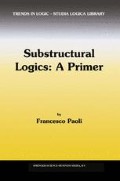Abstract
In Chapter 1, we discussed at some length the importance of cut elimination, both from a philosophical and from a technical viewpoint. Hitherto, however, we did not prove the cut elimination theorem for any of the systems so far introduced. This will be exactly the task of the present chapter. For a start, we shall present Gentzen’s proof of the Haupsatz for LK; coming to know how such a proof works is essential also from our perspective, for it allows to appreciate the role that structural rules play in it. Subsequently, we shall assess how Gentzen’s strategy should be modified in order to obtain the elimination of cuts for systems lacking some of the structural rules. We shall also show, with the aid of appropriate counterexamples, that not all of our sequent systems are cut-free.
Access this chapter
Tax calculation will be finalised at checkout
Purchases are for personal use only
Preview
Unable to display preview. Download preview PDF.
Notes
From now on, the terms “inference” and “application of a rule” will be used interchangeably.
Remark that our definition of rank is not the standard one to be found in most textbooks. As a rule, the notion of rank is undefined for proper subproofs of a mixproof; we believe, on the other hand, that our definition may have some didactical advantages, since it allows to “visualize” the gain in rank obtained with each reduction step.
To be sure, such a recourse to the mix rule can be avoided. As von Plato (2001) recently suggested, it is possible to prove the Hauptsatz even for LK and LJ by eliminating plain cuts: one has to distinguish several cases according to how the auxiliary formulae of contraction inferences were introduced into the proof at issue.
It is left up to the reader to verify that, in the subcases of the inductive step involving rules with two premisses, one may bump into sequents whose antecedents, or succedents, contain three occurrences of a formula; this is the reason why we need to consider 3-reduced sequents.
Author information
Authors and Affiliations
Rights and permissions
Copyright information
© 2002 Springer Science+Business Media Dordrecht
About this chapter
Cite this chapter
Paoli, F. (2002). Cut Elimination and the Decision Problem. In: Substructural Logics: A Primer. Trends in Logic, vol 13. Springer, Dordrecht. https://doi.org/10.1007/978-94-017-3179-9_3
Download citation
DOI: https://doi.org/10.1007/978-94-017-3179-9_3
Publisher Name: Springer, Dordrecht
Print ISBN: 978-90-481-6014-3
Online ISBN: 978-94-017-3179-9
eBook Packages: Springer Book Archive

